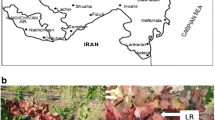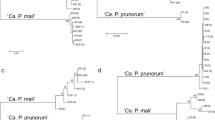Abstract
Uncultivable bacteria from the genus ‘Candidatus Phytoplasma’ are associated with grapevine yellows (GY) diseases worldwide. In Euro-Mediterranean viticultural areas, GY are most frequently caused by Bois Noir (BN) and Flavescence Dorée (FD) phytoplasmas. Surveys of GY in Croatia have been conducted regularly since 1997. BN phytoplasmas have been found to be widespread, while FD phytoplasmas were recently discovered in restricted areas of the country. The aim of this study was to assess the variability of genotypes involved in GY pathosystems by a multilocus sequence typing (MLST) approach. Grapevine, weed and insect vector samples were collected from three locations. Species-specific stamp and vmp1 genes, together with house-keeping genes tuf and secY, were amplified from BN strains. In FD strains, the genes secY, map and uvrB-degV were analyzed. MLST revealed a diversity of BN genotypes, one of which was prevalent and identified in samples of grapevine and the insect vector Hyalesthes obsoletus, corroborating their affiliation to the same pathosystem. Distinct BN strains found in bindweed and two grapevine samples indicated the presence of different BN pathosystems involving a yet unidentified vector, possibly from the genus Reptalus. Moreover, a co-occurence of BN and FD phytoplasma in the same vineyard was identified. The genotyping of FD strains from both grapevine and Scaphoideus titanus showed the presence of at least two distinct FD genotypes at two different locations, suggesting separate introductions of the disease into the country. In this study, MLST proved to be a useful and informative tool in advancing the understanding of GY epidemiology in Croatia.




Similar content being viewed by others
References
Angelini, E., Squizzato, F., Lucchetta, G., & Borgo, M. (2004). Detection of a phytoplasma associated with grapevine Flavescence dorée in Clematis vitalba. European Journal of Plant Pathology, 110, 193–201.
Arnaud, G., Malembic-Maher, S., Salar, P., Bonnet, P., Maixner, M., Marcone, C., et al. (2007). Multilocus sequence typing confirms the close genetic interrelatedness of three distinct flavescence dorée phytoplasma strain clusters and group 16SrV phytoplasmas infecting grapevine and alder in Europe. Applied and Environmental Microbiology, 73, 4001–4010.
Aryan, A., Brader, G., Mörtel, J., Pastar, M., & Riedle-Bauer, M. (2014). An abundant ‘Candidatus Phytoplasma solani’ tuf b strain is associated with grapevine, stinging nettle and Hyalesthes obsoletus. European Journal of Plant Pathology, 140, 213–227.
Bertaccini, A., & Duduk, B. (2009). Phytoplasma and phytoplasma diseases: a review of recent research. Phytopathologia Mediterranea, 48, 355–378.
Budinšćak, Ž. (2008). Vectors of fruit tree and grapevine phytoplasmas in Republic of Croatia. PhD Thesis. University of Osijek.
Cimerman, A., Pacifico, D., Salar, P., Marzachì, C., & Foissac, X. (2009). The striking diversity of vmp1, a gene encoding a variable putative membrane protein of the Stolbur phytoplasma. Applied and Environmental Microbiology, 75, 2951–2957.
Cvrković, T., Jović, J., Mitrović, M., Krstić, O., & Toševski, I. (2014). Experimental and molecular evidence of Reptalus panzeri as a natural vector of bois noir. Plant Pathology, 63, 42–53.
Danet, J. L., Balakishiyeva, G., Cimerman, A., Sauvion, N., Marie-Jeanne, V., Labonne, G., et al. (2011). Multilocus sequence analysis reveals the genetic diversity of European fruit tree phytoplasmas and supports the existence of inter-species recombination. Microbiology, 157, 438–50.
Deng, S., & Hiruki, C. (1991). Amplification of 16S rRNA genes from culturable and non-culturable Mollicutes. Journal of Microbiological Methods, 14, 53–61.
EPPO (2014). PQR - EPPO database on quarantine pests (available online). http://www.eppo.int
Fabre, A., Danet, J. L., & Foissac, X. (2011). The stolbur phytoplasma antigenic membrane protein gene stamp is submitted to diversifying positive selection. Gene, 472, 37–41.
Fialová, R., Válová, P., Balakishiyeva, G., Danet, J. L., Šafárová, D., Foissac, X., et al. (2009). Genetic variability of stolbur phytoplasma in annual crop and wild plant species in south Moravia. Journal of Plant Pathology, 91, 411–416.
Filippin, L., Jović, J., Cvrković, T., Forte, V., Clair, D., Toševski, I., et al. (2009). Molecular characteristics of phytoplasmas associated with Flavescence dorée in clematis and grapevine and preliminary results on the role of Dyctiophara europea as a vector. Plant Pathology, 58, 826–837.
Filippin, L., De Pra, V., Zottini, M., Borgo, M., & Angelini, E. (2011). Nucleotide sequencing of imp gene in phytoplasmas associated to ‘flavescence dorée’ from Ailanthus altissima. Bulletin of Insectology, 64, S49–S50.
Foissac, X., Danet, J. L., Malembic-Maher, S., Salar, P., Šafářová, D., Válová, P., et al. (2013a). Tuf and SecY PCR Amplification and Genotyping of Phytoplasmas. In J. Hodggetts & M. Dickinson (Eds.), Phytoplasma methods and protocols (pp. 189–204). New York: Humana Press.
Foissac, X., Carle, P., Fabre, A., Salar, P., Danet, J. L., & STOLBUR-EUROMED consortium. (2013b). ‘Candidatus Phytoplasma solani’ genome project and genetic diversity in the Euro-Mediterranean basin. 3rd European Bois noir Workshop (pp. 11–13). Barcelona: Proceedings of the 3rd European Bois noir Workshop.
Galetto, L., Bosco, D., Balestrini, R., Genre, A., Fletcher, J., & Marzachì, C. (2011). The major antigenic membrane protein of ‘Candidatus phytoplasma asteris’ selectively interacts with ATP synthase and actin of leafhopper vectors. PLoS One, 6, e22571.
Johannesen, J., Foissac, X., Kehrli, P., & Maixner, M. (2012). Impact of vector dispersal and host-plant fidelity on the dissemination of an emerging plant pathogen. Plos One, 7(12), e51809.
Jović, J., Cvrković, T., Mitrović, M., Krnjajić, S., Petrović, A., Redinbaugh, M. G., et al. (2009). Stolbur phyoplasma transmission to maize by Reptalus panzeri and the disease cycle of maize redness in Serbia. Phytopathology, 99, 1053–1061.
Kuzmanović, S., Martini, M., Ermacora, P., Ferrini, F., Starović, M., Tošić, M., et al. (2008). Incidence and molecular characterization of flavescence dorée and stolbur phytoplasmas in grapevine cultivars from different viticultural areas of Serbia. Vitis, 47, 105–111.
Langer, M., & Maixner, M. (2004). Molecular characterization of grapevine-yellows-associated phytoplasmas of the stolbur group, based on RFLP-analysis of non-ribosomal DNA. Vitis, 43, 191–200.
Lee, I. M., Gundersen-Rindal, D. E., Davis, R. E., & Bartoszyk, I. M. (1998). Revised classification scheme of phytoplasmas based on RFLP analyses of 16S rRNA and ribosomal protein gene sequences. International Journal of Systematic and Evolutionary Microbiology, 48, 1153–1169.
Lee, I. M., Zhao, Y., & Davis, R. E. (2010). Prospects of multiple gene-based systems for differentiation and classification of phytoplasmas. In P. G. Weintraub & P. Jones (Eds.), Phytoplasmas: Genomes, plant hosts and vectors (pp. 51–63). Wallingford: CABI.
Maixner, M. (2011). Recent advances in Bois noir research. Petria, 21, 17–32.
Maixner, M., & Reinert, W. (1999). Oncopsis alni (Schrank) (Auchenorrhyncha: Cicadellidae) as a vector of the alder yellows phytoplasma of Alnus glutinosa (L.) Gaertn. European Journal of Plant Pathology, 105, 87–94.
Mehle, N., Rupar, M., Seljak, G., Ravnikar, M., & Dermastia, M. (2011). Molecular diversity of ‘flavescence dorée’ phytoplasma strains in Slovenia. Bulletin of Insectology, 64, 29–30.
Mikec, I., Križanac, I., Budinščak, Ž., Šeruga Musić, M., Krajačić, M., & Škorić, D. (2006). Phytoplasmas and their potential vectors in vineyards of indigenous Croatian varieties. Extended abstracts 15th Meeting ICVG (pp. 255–257). Stellenbosch: South African Society for Enology and Viticulture.
Murolo, S., Marcone, C., Prota, V., Garau, R., Foissac, X., & Romanazzi, G. (2010). Genetic variability of the stolbur phytoplasma vmp1 gene in grapevines, bindweeds and vegetables. Journal of Applied Microbiology, 109, 2049–2059.
Murolo, S., Mancini, V., & Romanazzi, G. (2014). Spatial and temporal stolbur population structure in a cv. Chardonnay vineyard according to vmp1 gene characterization. Plant Pathology, 63, 700–707.
Pacifico, D., Alma, A., Bagnoli, B., Foissac, X., Pasquini, G., Tessitori, M., et al. (2009). Characterization of Bois noir isolates by restriction fragment length polymorphism of a Stolbur-specific putative membrane protein gene. Phytopathology, 99, 711–715.
Pelletier, C., Salar, P., Gillet, J., Cloquemin, G., Very, P., Foissac, X., et al. (2009). Triplex real-time PCR assay for sensitive and simultaneous detection of grapevine phytoplasmas of the 16SrV and 16SrXII-A groups with an endogenous analytical control. Vitis, 48, 87–95.
Pinzauti, F., Trivellone, V., & Bagnoli, B. (2008). Ability of Reptalus quinquecostatus (Hemiptera: Cixiidae) to inoculate phytoplasma to artificial feeding medium. Annals of Applied Biology, 153, 299–305.
Quaglino, F., Zhao, Y., Casati, P., Bulgari, D., Bianco, P. A., Wei, W., et al. (2013). ‘Candidatus Phytoplasma solani’, a novel taxon associated with stolbur and bois noir related diseases of plants. International Journal of Systematic and Evolutionary Microbiology, 63, 2879–2894.
Riedle-Bauer, M., Sara, A., & Regner, F. (2008). Transmission of a stolbur phytoplasma by the agalliinae leafhopper anaceratagallia ribauti (Hemiptera, Auchenorrhyncha, Cicadellidae). Journal of Phytopathology, 156, 687–690.
Schneider, B., Gibb, K. S., & Seemüller, E. (1997). Sequence and RFLP analysis of the elongation factor Tu gene in differentiation and classification of phytoplasmas. Microbiology, 143, 3381–3389.
Schvester, D., Carle, P., & Moutous, G. (1969). Nouvelles données sur la transmission de la Flavescence dorée de la vigne par Scaphoideus littoralis Ball. Annales de Zoologie Ecologie Animale, 1, 445–465.
Šeruga Musić, M., Škorić, D., Budinščak, Ž., Križanac, I., & Mikec, I. (2009). Survey of phytoplasma diversity in heavily grapevine yellows-affected areas of Croatia (pp. 206–207). Hors Série: Le Progrès Agricole et Viticole.
Šeruga Musić, M., Škorić, D., Haluška, I., Križanac, I., Plavec, J., & Mikec, I. (2011). First report of flavescence dorée-related phytoplasma affecting grapevines in Croatia. Plant Disease, 95, 353.
Šeruga Musić, M., Duc Nguyen, H., Černi, S., Mamula, Đ., Ohshima, K., & Škorić, D. (2014). Multilocus sequence analysis of ‘Candidatus phytoplasma asteris’ strain and the genome analysis of Turnip mosaic virus co-infecting oilseed rape. Journal of Applied Microbiology, 117, 774–785.
Šeruga, M., Ćurković Perica, M., Škorić, D., Kozina, B., Mirošević, N., Šarić, A., et al. (2000). Geographical distribution of bois noir phytoplasmas infecting grapevines in Croatia. Journal of Phytopathology, 148, 239–242.
Šeruga, M., Škorić, D., Botti, S., Paltrinieri, S., Juretić, N., & Bertaccini, A. F. (2003). Molecular characterization of a phytoplasma from the aster yellows (16SrI) group naturally infecting Populus nigra L. ‘Italica’ trees in Croatia. Forest Pathology, 33, 113–125.
Sforza, R., Clair, D., Daire, X., Larrue, J., & Boudon-Padieu, E. (1998). The role of Hyalesthes obsoletus (Hemiptera: Cixiidae) in the occurrence of bois noir of grapevines in France. Journal of Phytopathology, 146, 549–556.
Sforza, R., Bourgoin, T., Wilson, S. W., & Boudon-Padieu, E. (1999). Field observations, laboratory rearing and descriptions of immatures of the planthopper Hyalesthes obsoletus (Hemiptera: Cixiidae). European Journal of Entomology, 96, 409–418.
Sharon, R., Soroker, V., Wesley, D. S., Zahavi, T., Harari, A., & Weintraub, P. G. (2005). Vitex agnus-castus is a preferred host plant for Hyalesthes obsoletus. Journal of Chemical Ecology, 31, 1051–1063.
Smart, C. D., Schneider, B., Blomquist, C. L., Guerra, L. J., Harrison, N. A., Ahrens, U., et al. (1996). Phytoplasma-specific PCR primers based on sequences of the 16S-23S rRNA spacer region. Applied and Environmental Microbiology, 62, 1988–93.
Suzuki, S., Oshima, K., Kakizawa, S., Arashida, R., Jung, H. Y., & Yamaji, Y. (2006). Interaction between the membrane protein of a pathogen and insect microfilament complex determines insect-vector specificity. Proceedings of the National Academy of Science of the USA, 103, 4252–4257.
Tamura, K., Peterson, D., Peterson, N., Stecher, G., Nei, M., & Kumar, S. (2011). MEGA5: molecular evolutionary genetics analysis using maximum likelihood, evolutionary distance, and maximum parsimony methods. Molecular Biology and Evolution, 28, 2731–2739.
Thompson, J. D., Gibbson, T. J., Plewniak, F., Jeanmougin, F., & Higgins, D. G. (1997). The ClustalX windows interface: flexible strategies for multiple sequence alignment aided by quality analysis tools. Nucleic Acids Research, 25, 4876–4882.
Urwin, R., & Maiden, M. C. J. (2003). Multi locus sequence typing: a tool for global epidemiology. Trends in Microbiology, 11, 479–487.
Acknowledgments
The authors would like to acknowledge Dr. Xavier Foissac for kindly providing reference strains.
Compliance with Ethical Standards
This research fully complies with Ethical Standards applicable for this journal and the relevant national and international ethics related rules and professional codes of conduct.
Funding
This study was funded by the Croatian Ministry of Science Education and Sports (grant number 119-1191192-1222) and by the Ministry of Agriculture (National Survey of Quarantine Organisms Programme).
Conflict of interest
The authors declare that they have no conflict of interest.
Author information
Authors and Affiliations
Corresponding author
Rights and permissions
About this article
Cite this article
Plavec, J., Križanac, I., Budinšćak, Ž. et al. A case study of FD and BN phytoplasma variability in Croatia: multigene sequence analysis approach. Eur J Plant Pathol 142, 591–601 (2015). https://doi.org/10.1007/s10658-015-0637-4
Accepted:
Published:
Issue Date:
DOI: https://doi.org/10.1007/s10658-015-0637-4




